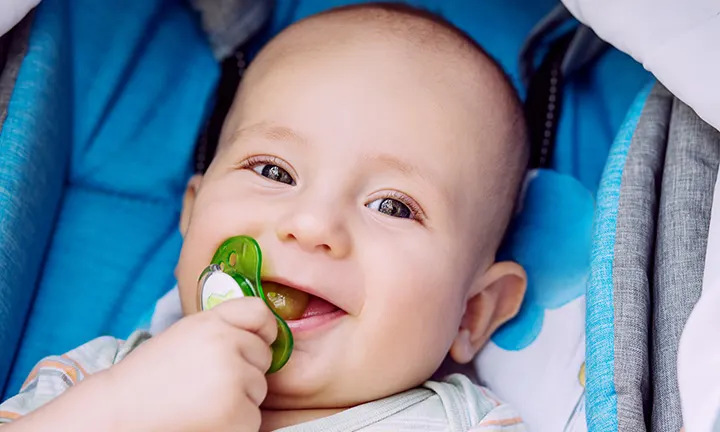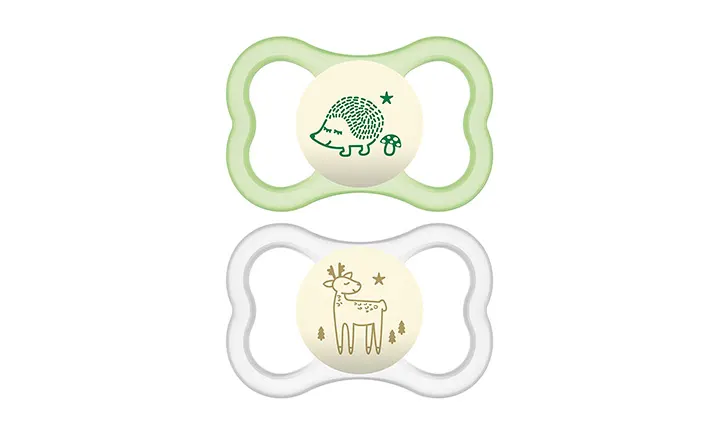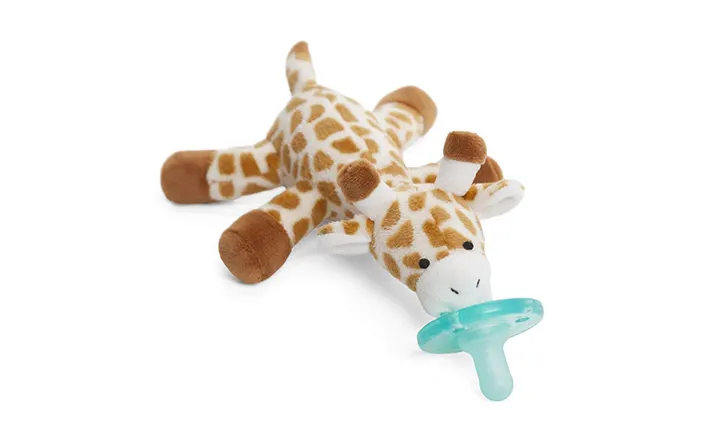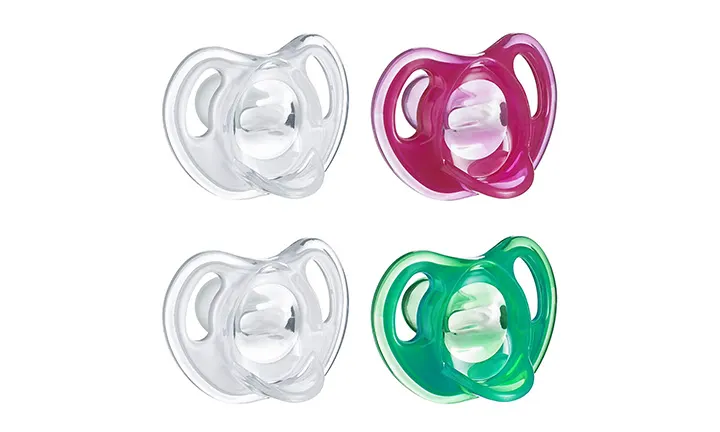The Best Pacifiers for Your Baby
Pacifiers are a great way to help your baby self-soothe if they enjoy the sucking action. Because you can’t really tell ahead of time which pacifier your little one will like best, you may wish to buy a few types and try them all until you find which one your baby likes.
To help you select a couple of pacifiers to try, we surveyed more than 7,000 Pampers Parents to discover which one they like the best and to pass along some pros and cons of each product.
Why Your Baby Might Love a Pacifier
Newborn babies have a strong sucking reflex, and many babies enjoy the soothing sensation that sucking provides. Beyond what nursing or a bottle can provide, your newborn baby might love the chance to suck on a pacifier after or between feedings.
The key to offering your baby a pacifier is to follow their cues about whether they feel like taking it or not, and not to force it.
Another guideline is that you shouldn’t give your little one a pacifier as a way to delay or replace a feeding; rather, it should be given to satisfy your baby’s desire to continue to suck. This is why a great time to offer your baby a pacifier is after a feeding.
You may also like to offer the pacifier to your little one at bedtime, as experts say it may help them calm down and fall asleep. Sucking on a pacifier at bedtime may also reduce the risk of sudden infant death syndrome (SIDS).
Nevertheless, if your baby doesn’t want the pacifier or if it falls out of their mouth while they’re asleep, there’s no need to place the pacifier back in your baby’s mouth.
You might have heard that using pacifiers for a long time can harm the development of your baby’s teeth and gums, but according to children’s health experts, normal pacifier use in the first few years won’t lead to any long-term problems. If you’re unsure or if you have any questions about pacifier is best, ask your baby’s healthcare provider or dentist.
If you’re breastfeeding, don’t introduce a pacifier until your newborn is at least 1 month old and your breastfeeding routine is on track. This is so the action of sucking on a pacifier doesn’t lead to what’s called “nipple confusion,” which can make it harder for your newborn to learn to suck on your nipple during feedings.
Once your child is about 1 year old, ask your healthcare provider for a personalized recommendation on when to start weaning your little one off the pacifier.
9 Things to Consider When Buying a Pacifier
These are some of the factors to consider when deciding which may be the best pacifier for your baby:
Safety. Check that the pacifier meets safety standards set by the Juvenile Products Manufacturers Association (JPMA) and hasn’t been recalled. Experts also recommend the pacifier be made of one piece as this helps reduce the risk of small parts breaking off. Small parts can be a choking hazard. Multiple-piece pacifiers typically have a nipple, a guard or shield, and a ring, which are stuck together but could become unstuck. Never buy a pacifier that has a string, ribbon, or cord on it, as these can be strangulation hazards. You also shouldn’t use anything to attach the pacifier to your little one’s clothes, hands, or the crib, for the same reason.
Shape. Experts recommend giving a pacifier that has a soft nipple. A pacifier nipple with a round tip may be more “nipple-like,” while an “orthodontic” nipple typically has a flatter side and an angled shape. Manufacturers often make claims about their pacifier being better for your baby’s orthodontic development or better at preventing nipple confusion. According to experts, most of the pacifiers sold in the United States are orthodontically correct, and it’s probably best to ask your baby’s healthcare provider about which pacifier is best for your baby’s healthy development. Ultimately, the best pacifier nipple is often the one that your little one enjoys using.
Material. Experts recommend choosing a pacifier made of silicone. Babies are often allergic to latex, so it may be safest to avoid pacifiers that have latex in them. Once you have some pacifiers at home, check them from time to time to make sure no pits are missing and that they haven’t fallen apart. Some manufacturers claim their material helps prevent the pacifier from discoloring or losing its shape. Even if this is the case, you should keep an eye on the pacifier over the course of its use and discard it if it does bend out of shape.
Ventilation. Make sure there are small holes on the pacifier shield to allow for ventilation. This helps prevent the buildup of moisture on your little one’s skin.
Cleanability. Choose a pacifier that is dishwasher safe or one that can be boiled so it’s easy to keep clean. You should clean the pacifier regularly with one of the methods until your baby is 6 months old. After this time, rinsing it with soapy water may be enough as your baby’s immune system will be stronger.
Recommended age. Pacifiers come with an age recommendation, so make sure you buy one that suits your baby’s age. Remember to buy a new pacifier if your little one reaches the maximum age recommended by the manufacturer of your existing pacifiers. Most of the pacifiers on this list are good for the first three to six months, but many manufacturers also offer the same pacifier in a bigger size for when your baby is older and it’s time to upgrade.
Size. For your little one’s safety, the shield (sometimes called the “guard”) should be at least 1-1/2 inches across. It should not be able to fit in your little one’s mouth.
Design. Pacifiers come in different colors and styles. One pacifier on this Pampers Parents list even comes with an attached plush animal that your little one might love.
Number of pacifiers. It’s easy for pacifiers to become lost—dropped on the ground or behind the couch, for example. You might want to buy several at once or buy a multipack. Because your baby may not take to one pacifier or another, you may like to buy a few different kinds to try them out and see which one your baby prefers. Once you’ve found the best pacifier for your baby, buy some spares to have on hand.
The 8 Best Pacifiers
These are the eight best baby pacifiers as chosen by Pampers Parents:
1. Philips Avent Soothie Pacifier
Why pick this one? The Soothie pacifier by Philips Avent is the very best pacifier for newborns according to Pampers Parents. Some parents also felt it was the best pacifier for their breastfed baby. This Avent pacifier is made of a single piece of hospital-grade silicone. The manufacturer claims the material resists discoloration and changes in shape—although you should still keep an eye out for this, just in case. The manufacturer also claims the shape of the pacifier’s nipple won’t affect the healthy development of your baby’s teeth and gums. Keep in mind that you should trust your healthcare provider’s advice on this subject.
The shape of the nipple is round, and the shape of the shield is also round. One consideration is that the shield has none of the contours or cutouts that some of the other pacifiers on this list offer. On the plus side, unlike some of the other pacifiers on this list, the Soothie comes in lots of colors including blue, green, pink, yellow, and purple. This pacifier is BPA and latex free. It’s also dishwasher safe for easy cleaning; however, you can also boil it or clean it with a steam sterilizer, if you have one. Highlights: The manufacturer claims it doesn’t have a taste or odor, so your little one is more likely to accept it.
Price*: about $7.49 on Amazon.com
2. MAM Air Night Pacifiers
Why pick this one? What sets this set of pacifiers from MAM apart from the rest is that they glow in the dark. This feature is helpful at night, in case one gets lost or misplaced.
The pacifiers also feature oversized curved shields with openings to ensure that the pacifier fits comfortably on your baby’s face and that sensitive skin can breathe while they use a pacifier.
According to the manufacturer, the pacifier was specially designed by pediatric dentists to ensure that it doesn’t impede your baby’s jaw and teeth development. The nipple is made with a special silicone and features an anti-slip texture, so it stays in your baby’s mouth more securely.
The pacifiers are manufactured free of BPA and BPS.
Just be aware that you can only start using these pacifiers once your baby turns 6 months old. You may need to buy another type of pacifier on this list before trying this one.
Highlights: The set of pacifiers includes a sterilizing storage case—simply insert the pacifiers into the case, add some water, and microwave for three minutes.
Price*: about $7.99 on Amazon.com
3. WubbaNub Infant Pacifier—Giraffe
Why pick this one? The really cool thing about this pacifier is that it comes with a plush animal toy that hangs off the end of the shield. Your baby will love holding onto the giraffe and may find it especially soothing.
The one downside of this design is that you may find the plush toy gets quite icky from all the drool, and the entire pacifier may be harder to keep clean as a result. This pacifier is not dishwasher safe, and the toy cannot be taken off the pacifier.
Although this pacifier is more expensive than the others on this list, the plush toy may make it worth it.
The nipple of the pacifier is round. There are two ventilation holes on the shield. The shield itself is a flat, round disk, without contours or cutouts, so you may find it doesn’t follow the curve of your baby’s face as much as some other models do.
The pacifier element is made of one piece of silicone. It’s latex, BPA, PVC, and phthalate free.
Highlights: Don’t care for the giraffe? You can also choose from a puppy, an elephant, a reindeer plush, and many more!
Price*: about $18.55 on Amazon.com
4. Tommee Tippee Ultra-Light Silicone Pacifiers
Why pick this one? If your baby’s pacifier is always falling out, you might like to try the Tommee Tippee pacifier, which comes in a set of four. The manufacturer claims this is the lightest pacifier and will stay longer in your baby’s mouth.
The pacifiers feature an orthodontic design with a symmetrical nipple to support the natural development of your baby’s teeth and gums. The medical-grade silicone nipple is flexible yet durable, and resists stains, odors, and tastes. The curved shield is designed to fit comfortably over your baby’s nose and chin and features plenty of large ventilation holes to prevent any moisture buildup against your baby’s face. Highlights: The pacifiers are made from a very durable material that was designed to be free of static and to stay cleaner longer. They can be cleaned in the dishwasher or in a sterilizer.
Price*: about $15.99 on Amazon.com
5. Itzy Ritzy Sweetie Soother Pacifier
Why pick this one? This pair of stylish pacifiers from Itsy Ritzy feature a one-piece cable design on the handle and are available in a multitude of colors for when you’d like to coordinate with your baby’s outfits.
Made from food-grade silicone, the pacifiers are also free of BPA and latex. The pacifier’s nipple is both soft and durable, which is good for when your baby starts teething. Two extra-large air holes ensure the pacifier is comfortable for your baby. A pacifier pod is sold separately if you’d like to have a way to store both pacifiers neatly and cleanly. Highlights: The pacifiers can be cleaned in the top rack of your dishwasher or sterilized in a microwave steam bag.
Price*: about $8.97 on Amazon.com
6. Dr. Brown’s HappyPaci
Why pick this one? This simple pacifier by Dr. Brown’s is made of silicone and has a one-piece construction. The nipple shape is round. The shield has a butterfly shape, which may make this pacifier more comfortable for your baby’s nose, cheeks, and chin. This pacifier can be placed in the dishwasher and sterilizer. It’s BPA free. It also comes in pink. If you give your little one a Dr. Brown’s bottle, you may find that the nipple of this pacifier likely matches the nipple of the bottle you use. Highlights: This pacifier comes in a pack of three, so if your little one is happy with the HappyPaci this is a great value purchase.
Price*: about $5.09 on Amazon.com
7. Nanobebe Pacifiers
Why pick this one? You may like to pick this Nanobebe pacifier if you’re looking for a round extra-soft nipple. This pacifier is mostly clear with a teal-colored trim, although it also comes in a pink, gray, and white version. Like the others on this list, this one is a one-piece silicone design. It’s also BPA and phthalate free. The handle on this pacifier is small compared to some of the other pacifiers on this list. This could be a pro or a con depending on your preferences. The shorter handle makes it less likely you’ll accidentally knock the pacifier out of your baby’s mouth, but the downside is that the pacifier will be harder to grab ahold of. If your baby likes this pacifier, you might like to upgrade to the same pacifier designed for babies aged 3 to 6 months when the time comes. Highlights: The ergonomic shape of the shield is the big plus of this pacifier. It’s curved to follow the contour of your baby’s face, and it has a cutout at the nose and the chin so as not to irritate your baby’s skin or cover their nose.
Price*: about $4.49 on Amazon.com
8. Chicco PhysioForma Soft Silicone Orthodontic Pacifiers
Why pick this one? The nipple of this pacifier is angled upward and shaped so that it’s flatter at the bottom and rounded at the top. There are tiny ridges on the flat side to encourage your little one’s tongue to sit against it. In this way, the manufacturer claims, your baby’s tongue will be coaxed forward, which helps to clear the airways. The base of the nipple is thin so that your little one can close their mouth over the nipple more easily than over a thicker nipple base. This pacifier is made of silicone with a satin feel. It’s both BPA and latex free. Once your baby is older, you can buy this same pacifier in designs for 6- to 12-month-olds, and for toddlers older than 16 months. Highlights: This pacifier comes with a storage case that also doubles as a sterilizer. Simply place the pacifier in its case with some water and microwave it for easy sterilization.
Price*: about $5.99 on Amazon.com
The Bottom Line
As you stock up on all the baby gear you need for your baby, don't forget to include a few different pacifiers. We hope you’re in luck and that your baby takes to one of the pacifiers that other Pampers Parents found worked well for their children.
Read more about Best Baby Products
Join a World of Support
through Pregnancy and Parenthood.
TRACK WITH TOOLS
LEARN WITH EXPERTS
GET REWARDED




















